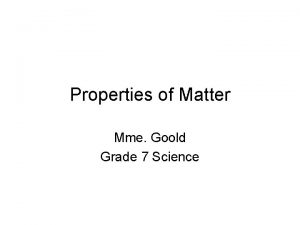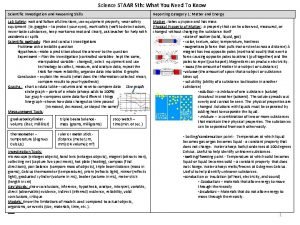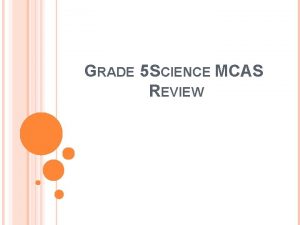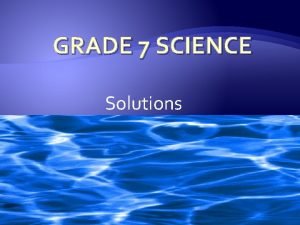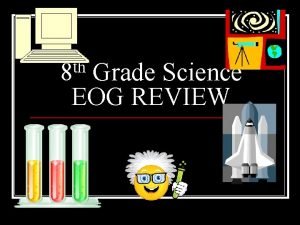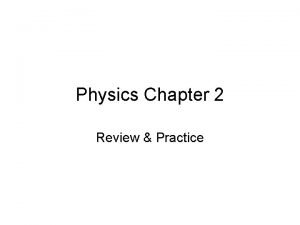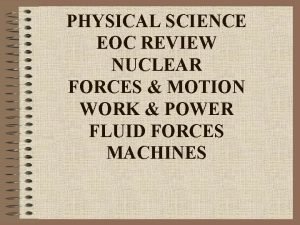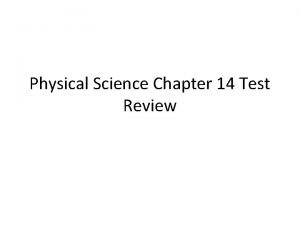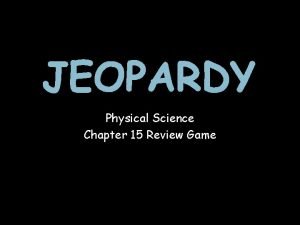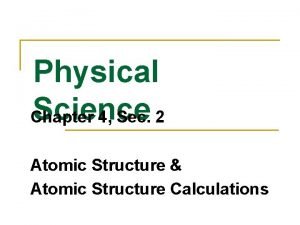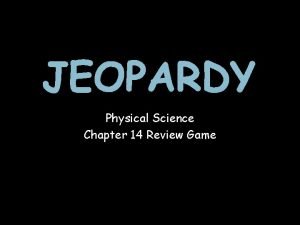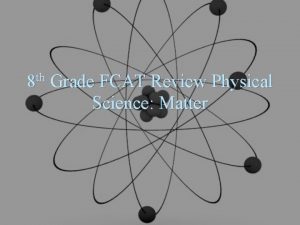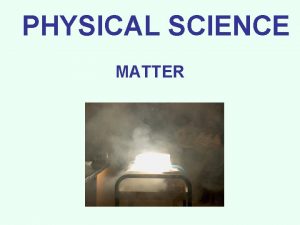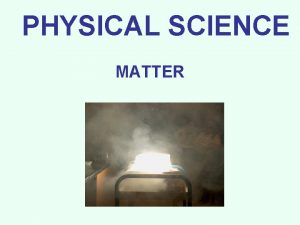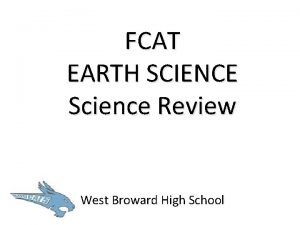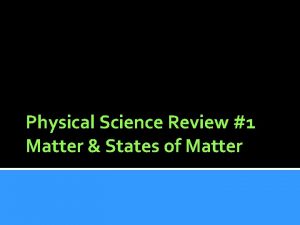th 8 Grade FCAT Review Physical Science Matter


























- Slides: 26

th 8 Grade FCAT Review Physical Science: Matter Assembled by: Jami Shaw and Amanda Braget

Atomic Theory • ATOMS ARE THE SMALLEST UNITS OF MATTER (FOR NOW). • ALL MATTER IS MADE UP OF ATOMS. • THE DIFFERENT WAYS ATOMS COMBINE CONTRIBUTE TO THE DIVERSITY OF ALL LIVING AND NONLIVING THINGS. • Trees, Dogs, DNA, Rocks, Metals, Water, People, etc. • WHEN ATOMS COMBINE IN DIFFERENT WAYS, THEY FORM COMPOUNDS.

Atomic Structure Nucleus has most of the mass Protons - positive electric charge - = Atomic (top) number - how many determines what element Neutrons - no electric charge - = AMU (bottom) – Atomic (top) Numbers Electron - negative electric charge - mass is almost 0 - The electron number of neutral atoms is = to the proton number. - flies around the nucleus at almost the speed of light

Phases of Matter § Matter is anything that has mass and takes up space (volume). § All matter is made up of atoms. § The phase/state that the matter is in depends on how the atoms are behaving. ØBased upon particle arrangement ØBased upon energy of particles ØBased upon distance between particles

Solids § Definite SHAPE, VOLUME, and MASS § Atoms of solids are tightly packed together. § Atoms of solids have slight vibrating movement. – Low Kinetic energy § To change a solid you can add heat/thermal/kinetic energy – Melt (solid to liquid) – Sublimation (solid to gas)

Liquids § Definite VOLUME and MASS. No definite SHAPE § Atoms of liquids are loosely held together. § Atoms of liquids have fluid movement. – Mid-level Kinetic energy § To change a liquid you can add or remove heat/thermal/kinetic energy – Adding energy - Boiling/ evaporation (liquid to gas) – Removing energy – Freezing (Liquid to solid)

§ Definite Mass. No definite Gases SHAPE or VOLUME. § Atoms of gases bounce off each other and expand to fill a given space. § Atoms of gases have very rapid continuous movement. – High Kinetic energy § To change a gas you can add or remove heat/thermal/kinetic energy – Adding energy – change to plasma (superheated gas) – Removing energy – Condensation (Gas to Liquid)

Organization of Matter – The Periodic Table • As you move from left to right, the elements go from being highly • • • reactive/unstable to being nonreactive/stable. • Alkali Metals (Group 1) – most reactive and unstable • The Noble gases (Group 18)- stable and nonreactive Each period begins with an element that has 1 valence electron and ends with an element that has 8 valence electrons. This repeating pattern means that the elements within a group always have the same number of valence electrons. As a result, the elements in each group have similar properties.

Classification of Matter Atom = all matter Molecule = multiple atoms Compounds = multiple same molecules Mixture = Multiple different molecules Homogeneous: looks the same, can’t easily separate (solution) Heterogeneous: looks different, can separate

Solutions Some homogeneous mixtures are made of chemicals that are able to dissolve. They are soluble. In a solution the smallest portion is the solute: Salt in saltwater In a solution the larger portion is the solvent: Water in saltwater A solution with a little solute is dilute: 1 drop on Mio in a bottle of water A solution with a lot of solute is concentrated: 20 drops of Mio in a bottle of water

Acid and Base Solutions Acid – low p. H (0 -6), makes H 3 O (hydronium) in solution Base – high p. H (8 -14), makes OH (hydroxide) in solution Salt – When an acid and a base combine and neutralize, p. H around 7 p. H scale- KNOW HOW TO READ IT!!!! Basic

WHY ARE CHEMICAL AND PHYSICAL PROPERTIES USEFUL? • HARNESS, TEXTURE, FLAMMABILITY, AND COLOR ARE ALL EXAMPLES OF PROPERTIES OF MATTER. • CHARACTERISTIC PROPERTIES OF MATTER CAN BE USED TO IDENTIFY UNKNOWN SUBSTANCES. • DENSITY, MAGNETISM, MELTING AND BOILING POINTS, AND THE ABILITY TO CONDUCT HEAT AND ELECTRICITY ARE SOME PROPERTIES THAT HOLD TRUE, REGARDLESS OF THE AMOUNT OF THE SAMPLE. PHYSIVAL PROPERTIES OF METALS • LUSTER-SHINY AND REFLECTIVE • MALLEABLE- A MATERIAL THAT CAN BE HAMMERED OR ROLLED INTO FLAT SHEETS OR OTHER SHAPES (AKA BENDABLE). • DUCTILE- MATERIAL THAT CAN BE PULLED OUT, OR DRAWN, INTO LONG WIRES. • THERMAL CONDUCTIVITY- ABILITY OF AN OBJECT TO TRANSFER HEAT. • ELECTRICAL CONDUCTIVITY- ABILITY TO CARRY ELECTRIC CURRENT. PHYSICAL PROPERTIES OF NONMETALS • MOST NONMETAL ARE POOR CONDUCTORS OF ELECTRIC

Physical and Chemical Changes PHYSICAL CHANGE • ANY CHANGE THAT ALTERS THE FORM OR APPEARANCE OF A SUBSTANCE BUT DOES NOT CHANGE INTO ANOTHER SUBSTANCE. • E. g. Cutting Paper CHEMICAL CHANGE • A CHANGE IN MATTER THAT PRODUCES ONE OR MORE NEW SUBSTANCES IS A CHEMICAL CHANGE. • Burning and rusting are both chemical changes. • E. g. Burning Paper • The substance that goes through the chemical change = reactant • The new substance that forms = product

Physical vs. Chemical Properties Which properties shown above are physical properties? Why are they considered physical?

Physical vs Chemical Changes Which images above are examples of physical changes and which are chemical changes? How do you know? SC. 8. P. 9. 2

Laws of Conservation of Mass MATTER IS NEVER CREATED NOR DESTROYED • WHEN CHEMICAL AND PHYSICAL CHANGED OCCUR IN CHEMISTRY, EVEN THOUGH IT MAY APPEAR THAT WAY, THE MASS GOING INTO THE REACTION IS EQUAL TO THE MASS COMING OUT. • The chemical changes may make this hard to see. Ex. Burning wood, corrosion of metals, etc. • RECALL THAT EARTH IS A SYSTEM MADE UP OF THE BIOSPHERE, GEOSPHERE, HYDROSPHERE, AND ATMOSPHERE. • ACCORDING TO THE CONSERVATION LAWS, THE TOTAL AMOUNT OF ENERGY IN THE EARTH SYSTEM STAYS CONSTANT.

Sample Question Susie is completing the table shown below: Column A Column B Na Na. Cl Ca Ca. Cl 2 Fe Fe 2 O 3 Pb Pb. N 6 What are the best headings for columns A and B? A. Column A: Atoms Column B: Mixtures B. Column A: Molecules Column B: Atoms C. Column A: Elements Column B: Compounds D. Column A: Atoms Column B: Elements

Sample Question After a particularly rainy spring, Kristen and Amanda could no longer bear to stay indoors and, with the first sign of fair weather, ventured outside for a walk through the park. As they passed the jungle gym, they noticed that the iron monkey bars looked different. What can you do to pure, solid iron to chemically change it? A. cut it B. melt it C. bend it D. oxidize it

Sample Question The elements iron (Fe), copper (Cu), and mercury (Hg) are classified as metals. Which physical property of metals do they all share? A. They are all magnetic B. They are all a shiny, reddish color. C. They all have the same melting points. D. They all have thermal and electrical conductivity.

Sample Question

Sample Question I DON’T like this question!!

Sample Question

Sample Question

Sample Question

Sample Question

Sample Question
 Science jeopardy 8th grade
Science jeopardy 8th grade Properties of materials grade 7 powerpoint
Properties of materials grade 7 powerpoint Term 2 natural science grade 7
Term 2 natural science grade 7 Matter and materials grade 7
Matter and materials grade 7 Grade 6 natural science term 3
Grade 6 natural science term 3 Persuasive quick write prompts
Persuasive quick write prompts Fcat writing
Fcat writing Www.fcatexplorer.com
Www.fcatexplorer.com Fcat star
Fcat star Fcat vs fsa
Fcat vs fsa Diameter if you know circumference
Diameter if you know circumference Reporting category 3 earth and space
Reporting category 3 earth and space Day 2 8th grade science staar review
Day 2 8th grade science staar review 5th grade science staar review
5th grade science staar review Mcas science grade 5
Mcas science grade 5 Solutions science grade 7
Solutions science grade 7 Chapter 3 review 8th grade science
Chapter 3 review 8th grade science 5th grade science eog review
5th grade science eog review Physical fitness components and tests grade 9
Physical fitness components and tests grade 9 Physrt
Physrt Physical science eoc study guide
Physical science eoc study guide Physical science eoc review
Physical science eoc review Section 4 review physical science
Section 4 review physical science A 120m long ski lift carries skiers
A 120m long ski lift carries skiers Physical science jeopardy
Physical science jeopardy Physical science chapter 4 review
Physical science chapter 4 review Chapter 14 review physical science
Chapter 14 review physical science



